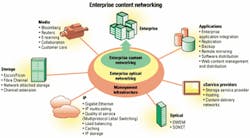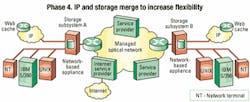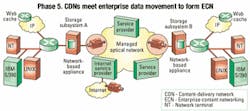The evolution of enterprise content networking
A new networking concept merges diverse data distribution requirements into a single unified infrastructure.
JON OLTSIK, GiantLoop Network
Enterprise companies need data-movement applications today for remote mirroring, backup, and replication, but proprietary, myopic technologies leave them drowning in a sea of point solutions. However, content-delivery networks (CDNs), which define an "intelligent cloud" that controls the movement and management of content across public and private IP networks, are still years away from enterprise acceptance. Given the similarities between these two application areas, the most attractive solution is a technical architecture that creates a unified infrastructure for disparate data movement applications today and establishes a foundation for content delivery applications of the future.
Enterprise content networking (ECN) is a comprehensive, unified architecture that meets enterprise requirements for both data-movement applications and CDNs. ECN encompasses all the technologies and constituencies in the data-movement and CDN industries including storage, IP networking, caching, optical transport, x-service provider (xSP), and content delivery services, data-movement applications, and multimedia providers (see Figure 1).Driven by the explosion of data, ECN will evolve through five phases:
- Phase 1. Proprietary data-movement solutions rule the day. Today, users must employ point solutions from application providers or hardware manufacturers. Enterprise IT will extend these systems through the addition of DWDM-based optical networks to provide geographic flexibility and real-time data protection as shown in Figure 2.
- Phase 2. Network appliances add to proprietary data-movement tools. By the end of 2001, network-based software and appliances from companies like Storage Apps, FalconStor, and DataCore will supplement proprietary systems for remote mirroring and storage virtualization. Once these appliances gain traction, IT will mirror additional systems-and require more bandwidth as shown in Figure 3.
- Phase 3. Service providers enter the fray. By the end of 2002, xSPs like Exodus, Genuity, and Storage Networks will join mainframe recovery heavyweights like SunGard and Comdisco to offer specialized services for storage mirroring and backup (see Figure 4). These service providers will give chief information officers (CIOs) additional data-movement options to address staff and skill shortages or capital budget concerns.
- Phase 4. IP networks extend storage flexibility. In early 2003, IP-based storage solutions from vendors like Cisco, Pirus Networks, and Nishan Systems will extend storage networks over private LANs and the Internet. Enterprise data-movement applications will gain additional flexibility as CIOs leverage IP infrastructure like domain name servers, routers, and load balancing to distribute data. This phase will also initiate the onset of ECN as IP-based cache from CacheFlow, Network Appliance, and Inktomi begins to leverage corporate storage-area network (SAN) resources as shown in Figure 5. Management tools that provide end-to-end visibility, hardened security, and policy-based functionality will accompany storage and IP interoperability.
- Phase 5. CDNs meet enterprise data movement. With IP and storage networks working in harmony, companies will start to add content delivery into the mix by 2004. Early requirements will be minimal but grow quickly. ECN will come to full fruition by 2005 as video for eLearning, collaboration, and customer care gets distributed and managed by the network as shown in Figure 6. ECN devices and tools will emerge to aggregate functionality, manageability, and operations. Early enterprise data movement xSPs will layer on CDN services to capture this market trend.
Service providers can offer multiple technical skill sets. ECN will move bits from disk to disk across networks speaking Escon/Ficon, Fibre Channel, and IP. Service providers have deep knowledge in these technologies, the underlying network infrastructure, and the devices connected to the networks.
They also maintain a policy of vendor and technology neutrality. Service providers can look across a broad spectrum of system, storage, and networking technologies to find established and cutting-edge ECN solutions that meet customer needs. These best-of-breed ECN solutions can then be delivered to customers as a managed service-not a bunch of technology piece parts.
Finally, service providers act as a customer proxy to the technology industry. Service providers use their position of vendor neutrality to drive the technology industry toward solutions offering interoperability, manageability, and open standards. By forcing technology vendors to play together, service pro viders can help accelerate technology benefits while avoiding interoperability headaches.
ECN is the first effort to bridge enterprise data movement and content delivery. It begins with enterprise optical-networking services and technologies that aggregate storage, networking, data-center, and multimedia traffic on a single, high-bandwidth network infrastructure. Enterprise optical networking transports today's data-movement applications and acts as a foundation for future CDNs. Combined with ECN partners, enterprise optical networking provides an end-to-end, managed infrastructure.The ECN management domain will expand to include customer-demanded devices, applications, and appliances. This additional functionality will give the service provider more data-center, network, and storage coverage, thus increasing its ability to help companies assess, manage, and extend their data-movement environments.
In the next phase, ECN will incorporate network services. That will add connectivity and management integration to hosting, storage, and business continuity service providers on the network. In this way, ECN will offer service choices that improve customers' technical and financial flexibility.Eventually, ECN will bridge the storage and data-networking world by supporting additional devices and connecting to the Internet. As a result, ECN will leverage existing IP tools and infrastructure to ease the storag-networking-management burden and open options to move storage traffic across existing LANs, MANs, WANs, and the Internet.
In addition to a managed environment including IP networking, storage, data-movement applications, and network-based services, ECN will add content-delivery applications, devices, services, and management tools. It will then leverage existing infrastructure to deliver rich content and new business-enabling functionality.ECN will be delivered to enterprise customers as managed services. These man aged services benefit customers by re placing extensive capital expenditures with predictable operating service contracts. ECN services also free companies from technically complex and time-consuming tasks such as vendor selection, equipment testing, systems integration, and ongoing management. Finally, ECN-managed services offer technology refresh programs to protect customers against in evitable technology obsolescence and churn.
ECN unites a number of disparate technologies and services under a common set of enterprise-focused services. As a result, the pace of technology innovation around ECN will pick up as the initiative gains momentum.
Data-movement intelligence moves to the network. By 2004, today's proprietary data-movement application model will become extinct, as the network controls policy, priority, routing, and security. Applications like replication, backup, content delivery, and software distribution will be written to the network through open application programming interfaces, communicate via extensible markup language, and use lightweight director access protocol directories for authentication and access control. These open interfaces will enable enterprises to plug and unplug ECN applications with relative ease.Management becomes intertwined. ECN initiates cooperation on technology interoperability and management integration. Once processes and standards are in place, a new class of adaptable options and comprehensive tools will surface, offering vast flexibility and customization. Enterprise IT will begin to see a comprehensive view of IT assets whether they live in the data center, at a service-provider site, or within a partner's facility. This trend will usher in the era of external IT.
Multimedia application will finally take hold. DWDM-based enterprise optical networks will have ample bandwidth to take advantage of any ECN application requirement. Early on, most applications won't come from in-house efforts; rather they will be provided by content providers such as Bloomberg, Reuters, and Dow Jones. Expect every trader on Wall Street to have real-time video on his or her desktop by 2003.
ECN is not a technology; it is an initiative to aggregate all technology components (storage, IP networks, optical transport, content delivery, applications, multi media, and xSP services) into service offerings that provide IT departments with near-term return on investment, greater efficiencies, and investment protection. ECN combines storage, data, and optical-networking skills, professional services, management infrastructure, and partner alliances. Through this combination, ECN can address today's enterprise requirements for mission-critical data-movement applications as well as future needs for multimedia-centric CDNs.
Jon Oltsik is vice president of corporate marketing at GiantLoop Network (Waltham, MA). He can be reached via the company's Website, www.giantloop.com.






